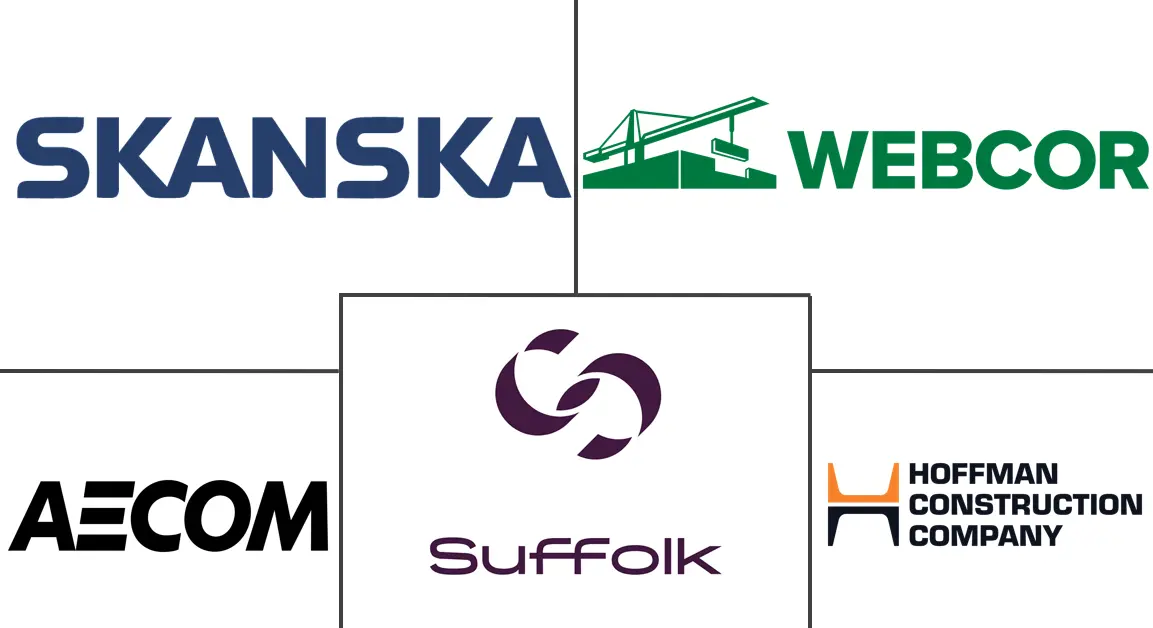Market Size of United States Transportation Infrastructure Construction Industry

| Study Period | 2020 - 2029 |
| Base Year For Estimation | 2023 |
| Market Size (2024) | USD 371.25 Billion |
| Market Size (2029) | USD 471.13 Billion |
| CAGR (2024 - 2029) | 4.88 % |
| Market Concentration | Low |
Major Players
*Disclaimer: Major Players sorted in no particular order |
US Transportation Infrastructure Construction Market Analysis
The United States Transportation Infrastructure Construction Market size is estimated at USD 371.25 billion in 2024, and is expected to reach USD 471.13 billion by 2029, growing at a CAGR of 4.88% during the forecast period (2024-2029).
About 39% of transportation and infrastructure spending in 2022 went to highway transportation, 28% to rail and mass transit, 22% to air travel, and 9% to water. Infrastructure and transportation spending in 2022 decreased by 21% from the year before, when spending reached a record high due to support for COVID-19, but is still 21% above 2019 levels before the pandemic.
State and local governments accounted for USD 211.8 billion in T&I spending in 2020 (excluding government transfers). This equated to 57% of total government T&I spending. In 2022, the federal government invested USD 36.6 trillion in infrastructure, with USD 94.5 trillion of that going directly to the states.
The bill set aside USD 550 billion for road, bridge, and rail projects, airports, broadband, and climate-related issues. The spending began in 2022 and is spread over five years. Approximately 66% of these funds were allocated to public utilities, including power and water infrastructure. On average, FEMA infrastructure spending post-disasters for public utilities accounted for 31% of the total FEMA infrastructure spending between 2000 and 2021.
As the world’s population continues to grow and the economy continues to expand, the number of customers will continue to grow, people and goods will continue to demand transportation, and the overall demand for transport will grow significantly. In the US, President Joe Biden unveiled a USD 2 trillion infrastructure plan to modernize the country’s infrastructure in the next decade.
US Transportation Infrastructure Construction Industry Segmentation
Transportation infrastructure construction involves a variety of construction activities, including reforming existing infrastructure, constructing new infrastructure, and expanding or demolishing existing infrastructure. A comprehensive analysis of the U.S. Transportation Infrastructure Construction market includes an overview of the economy, a forecast of market size for key market segments, and an analysis of emerging trends in key market segments.
The report sheds light on the market trends like growth factors, restraints, and opportunities in this sector. The competitive landscape of the United States Transportation Infrastructure Construction Market is depicted through the profiles of active key players. The report also covers the impact of COVID-19 on the market and future projections.
The United States transportation infrastructure construction market is segmented by type (roadways, railways, marine transportation, and airlines).
The market sizing and forecasts have been done for each segment based on value (USD).
| By Type | |
| Roadways | |
| Railways | |
| Airports | |
| Ports and Inland Waterways |
United States Transportation Infrastructure Construction Market Size Summary
The United States transportation infrastructure construction market is poised for significant growth over the coming years, driven by substantial federal and state investments aimed at modernizing and expanding the nation's infrastructure. The market is characterized by a diverse allocation of funds across various transportation sectors, including highways, rail, mass transit, air travel, and water transportation. The Bipartisan Infrastructure Act plays a pivotal role in this growth, providing extensive funding for critical projects such as roadways, bridges, and public transportation systems. This legislation not only addresses the immediate need for infrastructure repair and modernization but also emphasizes sustainability and technological advancements, encouraging companies to innovate and remain competitive in a rapidly evolving market.
The market landscape is shaped by major players like Skanska USA, Webcor Builders, AECOM, Suffolk Construction, and Hoffman Construction, who are actively involved in large-scale projects across the country. The demand for improved transportation infrastructure is further fueled by population growth and economic expansion, which increase the need for efficient movement of people and goods. Federal initiatives, including President Biden's infrastructure plan, aim to enhance the country's transportation networks, with a focus on reducing emissions and improving accessibility. As the market continues to expand, it presents opportunities for both public and private sectors to collaborate on projects that will define the future of U.S. transportation infrastructure.
United States Transportation Infrastructure Construction Market Size - Table of Contents
-
1. Market Insights
-
1.1 Market Overview
-
1.2 Market Dynamics
-
1.2.1 Drivers
-
1.2.1.1 Increase In Tourism Industry
-
1.2.1.2 Sustainability and Environmental Concerns
-
-
1.2.2 Restraints
-
1.2.2.1 Financial Constraints
-
1.2.2.2 High Maintenance
-
-
1.2.3 Opportunities
-
1.2.3.1 Technological Advancements
-
-
-
1.3 Government Regulations and Initiatives
-
1.4 Supply Chain/Value Chain Analysis
-
1.5 Technology Snapshot and Digital Trends
-
1.6 Major Infrastructure Development Projects
-
1.7 Porter's Five Forces Analysis
-
1.7.1 Bargaining Power of Suppliers
-
1.7.2 Bargaining Power of Consumers/Buyers
-
1.7.3 Threat of New Entrants
-
1.7.4 Threat of Substitute Products
-
1.7.5 Intensity of Competitive Rivalry
-
-
1.8 Impact of COVID-19 on the Market
-
-
2. Market Segmentation
-
2.1 By Type
-
2.1.1 Roadways
-
2.1.2 Railways
-
2.1.3 Airports
-
2.1.4 Ports and Inland Waterways
-
-
United States Transportation Infrastructure Construction Market Size FAQs
How big is the United States Transportation Infrastructure Construction Market?
The United States Transportation Infrastructure Construction Market size is expected to reach USD 371.25 billion in 2024 and grow at a CAGR of 4.88% to reach USD 471.13 billion by 2029.
What is the current United States Transportation Infrastructure Construction Market size?
In 2024, the United States Transportation Infrastructure Construction Market size is expected to reach USD 371.25 billion.

